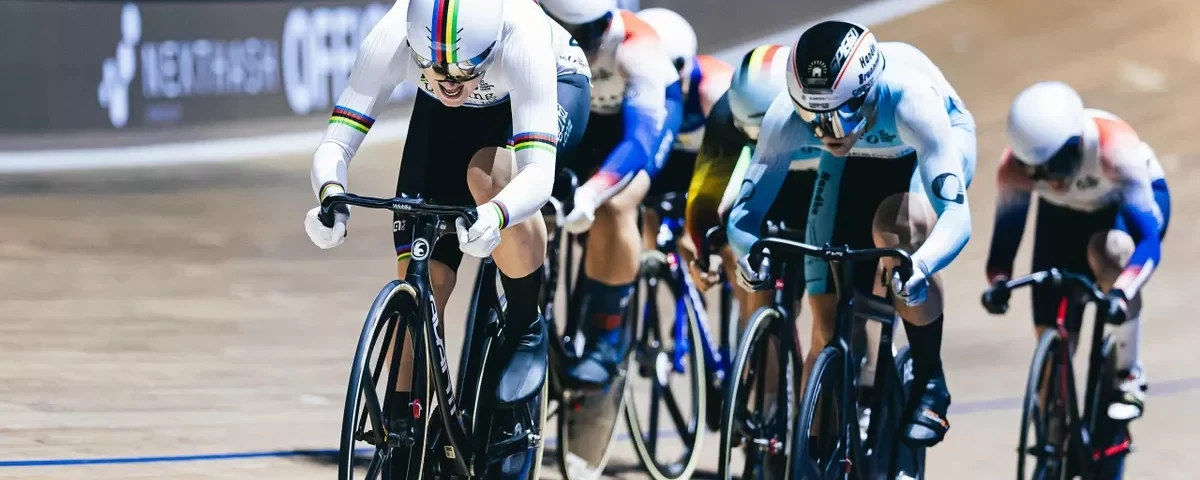This article is part 3 and the final part of our trilogy on aerodynamics. So far, we have learned about the physical phenomenon of cycling aerodynamics in Part 1 and how aerodynamic effects on cyclists are interconnected, complex and difficult to measure in Part 2. Still, for the majority of riders, it is highly recommended to invest in and prioritize aerodynamics. This post outlines a couple of key principles to follow when searching for equipment in order to maximize aerodynamic effects, as well as how to make the most of these effects during racing.
The final goal is always speed, not aero or lightest
Let’s start with the obvious one: a bike race is won by the rider who goes fastest from start to finish. Amazing, isn’t it? So the goal will always be speed, not most aero or lightest. It goes without saying that the chances of success in cycling races increase for the best-trained athletes who can sustain higher power for longer periods of time. On race day, regardless of your physical ability, you can optimize your speed by riding intelligently and selecting appropriate gear. Understanding the principles of aerodynamics helps you to make informed decisions about the equipment you choose to buy and influences your riding style.
This article will cover this in more detail. If you’re interested in training advice, you can always sign up for our subscriber list. We’ll share our favorite training resources with you and occasionally recommend useful videos or podcasts.
Races are won by the fastest rider. It’s not about being the lightest or most aerodynamic – it’s all about being the faster. No matter your strength, you can boost your speed by riding smart and choosing the right gear.
Most of a cyclist’s power will be used to overcome aerodynamic drag
The apparent first question is where you want to put the focus on and spend the smart money? You will quickly learn its aerodynamics. The graph below illustrates the percentage of power that a cyclist uses to overcome counterforces based on the road gradient. For most of your riding, the biggest force against going faster is aerodynamic drag, represented by the dark blue color. As the road gradient increases, you will need to exert more power to overcome gravity, which is depicted by the yellow color. The amount of power required to climb is influenced by the rider’s and bike’s combined weight, including any additional equipment.

At first glance, the graph can be a little misleading as it shows gradients ranging from 0% for a flat road to a very steep 10%. However, even the steepest climbs of the Tour de France, such as Alpe d’Huez, Mont Ventoux, or Col du Tourmalet have an average gradient of about 8%. Therefore, the average gradient you will experience during most races will be closer to the low single-digit numbers. Don’t forget, on most rides, you will also ride downhill after every mountain you climb up.
Besides the two most relevant forces, rolling resistance is another important contributor that we covered in a previous article. It constantly plays a role that contributes to and reinforces the argument in favor of fast tires and tubeless or its alternatives. Finally, mechanical efficiency as well makes a smaller contribution and is primarily down to how smooth your drive train runs. We will cover this in an article in the near future.
The importance of weight and aerodynamics depends on the course profile and rider speed
Balancing weight and aerodynamics is a somewhat complex optimization problem. To illustrate this, we can look at an example graph from BikeRumor that compares the aero-optimized Trek Madone from 2023 with the weight-optimized Trek Emonda from 2021. The graph shows the seconds saved per hour on the Trek Madone for different gradients, with different lines representing different average power levels ranging from 150 watts to 350 watts. Any value above zero indicates that the aero Madone will be faster. It is based on a typical rider weighing 73 kg, assuming no wind and a CDA of 0.3.
Typically, the Madone is faster on gradients below 3% and on all downward slopes. This is expected because the aero advantages come into play at higher speeds. However, for gradients above 3%, the bike’s speed will depend on the rider’s strength. A stronger rider will move faster, and so a rider producing 350 watts will find the Madone to be faster on gradients, even up to 6%. But for a rider producing only 150 watts, the tipping point of slower speed only occurs on gradients of 3.2% or lower. At this point, the Emonda is now the faster choice.

The difference between the Madone and the Emonda bikes is asymmetric. In the cases where the Emonda is faster, it saves much less than the advantages of the Madone. For instance, at the steepest gradients of 8%, the Emonda is faster by only 20 seconds per hour. However, even for weaker riders, the Madone already saves more seconds at gradients of 2%. This difference becomes ever more significant at everything below, where riders can save over 80 seconds per hour on a downhill.
Short story: Always choose the aero bike. Fortunately, with the latest bikes for the 2024 season, the difference between a lightweight bike and an aero bike seems to have disappeared. Pinarello knew this all along with the 2014 Dogma F8 and the latest Dogma F. More recently, Factor popularized the “quiver-killer” Ostro VAM and the trend is now continued with the latest Trek Madone and BMC Teammachine R.
Pro cyclists optimize setups for critical selection points even if it is not the overall fastest
What about the pro riders, you may ask? They still seem to care a lot about weight when the likes of Pogacar mount super light Carbon-Ti equipment to shave off the last grams. Their situation may be different to yours. Professional cyclists often prioritize weight when choosing their equipment because they are willing to expend more energy while tucked away in the peloton. Precisely because they aim to have every possible advantage when making a decisive attack on the final, steep climb. A prime example of this is the Milan-San Remo classic, where the Pogio climb is crucial. As a result, their equipment choices are not optimized for most of the course but are instead tailored to perform optimally on that critical final stretch.
Professional cyclists are concerned about weight because they seek every advantage during critical uphill sections. While their setup may not be the fastest overall, they have teammates who support them for the remainder of the race when they ride well below their maximum effort.
For most amateur cyclists, the situation is different. Unlike professional cyclists, we don’t have teammates to protect us during races. Instead, it’s more about being able to go fast overall. Additionally, most of us don’t have multiple bikes and setups for each race. We usually have one or maybe two race bikes.
Limitations are often given what kind of optimizations in aero and weight are possible
Finally, the other question is the feasibility of making significant changes. Minimizing weight is obviously only possible to a point. If you own a modern carbon race bike, you will have to invest heavily to save just half a kilogram without compromising aerodynamics or even safety. In the same way, if you are already quite athletic, reducing your body weight further without sacrificing power and health is very difficult. Most importantly, all is lost if you become sick or lose power.
Aero improvement on an individual level is hard to determine. Still, some gear choices, such as a fitted aero jersey, aero helmet, aero socks, aero wheels and, finally, an aero bike, will likely lead to gains.
Aerodynamics significantly impacts performance but is difficult to assess on an individual level, as we extensively discussed in part 2 of this series. It can be challenging to verify claims of something being “x percent faster” without the ability to verify external resources. Still, some gear choices like tight-fitted jerseys, aero socks, aero helmets, aero wheels, and an aero bike are likely to result in improved performance, even if the exact extent of the improvement is difficult to determine. This blog aims to gather all known information on gear that can make you faster and present it in a summarized form, empowering you to make informed choices: to Go faster, Roll Faster or simply Be Faster.
Use aerodynamics to your advantage on any bike ride
Although we talk a lot about equipment on this blog, minimizing wind resistance through aerodynamics can offer the biggest opportunity. Most of the information shared below might not be new to you, but some small yet essential details will be highlighted that you can use to your advantage.
Aerodynamics matters even if you ride at slower speeds
It’s commonly overlooked that aerodynamics are important even at slower speeds. Typically, the speed mentioned where aerodynamics become significant is 16 km/h (10 mph). Rolling resistance is the primary force to consider at speeds lower than that. As we previously discussed, your tire selection is likely the most influential factor in optimizing rolling resistance.

Most forget that the speed that matters is not the one you see on your bike computer but the wind speed you experience. You might be traveling up the mountain pass at a ground speed of only 8 km/h, but due to the slight headwind in the mountains, the effective wind speed could quickly exceed 16 km/h or more.
Wind may be faster than you think. The Beaufort scale is used to measure wind speeds empirically. Winds ranging from 6-11 km/h (4-7 mph) are classified as a light breeze, which is barely noticeable until weather vanes start to move. If you can see leaves and small twigs in constant motion or light flags extended, it is considered a gentle breeze, with speeds ranging from 12 to 16 km/h (8 – 12 mph). Beyond that, it becomes “windy” with a moderate breeze at 20-28 km/h (13-18 mph) and a fresh breeze at 29 – 38 km/h (19-24 mph), which are well beyond the threshold of a gentle breeze.
Likely, aerodynamics will affect your ride at any speed; even a light breeze can exceed the commonly cited limit of 16 km/h for a significant aerodynamic effect. What matters is wind speed, not ground speed. #CyclingMyth
To sum up, even if a smaller portion of your pedaling power is used to overcome aerodynamics, aero equipment can still provide significant benefits. This is particularly true in crosswinds, where the propulsive “sailing effect” of aero wheels can amplify the advantages of aerodynamics. As you ride slower, crosswinds will have a greater impact on your aerodynamics, making the benefits of aero wheels even more pronounced. Additionally, even though the effect may be less noticeable at slower speeds, you will often spend more time on the course, providing more opportunities for aerodynamic savings to accumulate.
Stay behind the biggies and 5-7 people into the pack
Drafting as close as possible to the rider in front of you is arguably the biggest advantage you can get. Most people are aware of this effect, but it’s surprising how strong it is. When you ride behind someone, you sit in the low-pressure air pocket that forms behind them, which means you experience “thinner air.” This effect is so significant that you can feel it. For a more detailed explanation, you can read part 1 of the trilogy on aerodynamics in cycling.

The effect of drafting is dependent on the size of the object you are drafting behind and your proximity to it. When drafting behind a single rider, you can experience a reduction in aerodynamic drag, ranging from 13.8% to 27.1%, depending on the aerodynamics of the rider in front of you. (research article). The more aerodynamic the rider in front of you, the less of a benefit you will get. This brings us to tip number one: always try to ride behind the biggest, least aero rider. In a breakaway or group ride, this can make quite some difference.
When cycling in a group, the drafting effect is more pronounced with more riders in front of you. The graph above shows that the second cyclist in a group of two gets a 15% drafting effect, while the eighth rider can get up to 35%. However, keep in mind that these values are based on a simulation of highly aerodynamic riders on time trial bikes, and the values can easily double if you are in a group on regular road bikes.
The best position in a peloton or group is about 5 to 7 riders back from the front. This allows for maximum aerodynamic advantage while still being able to respond to movements at the front and reduce the risk of crashing or experiencing the “accordion effect.”
Here is another tip: stay a few riders back in the peloton. This position allows you to react to attacks, avoid crashes, and prevent the “elastic effect” or “accordion effect.” Being further back only slightly improves drafting. It’s not surprising that most general classification riders prefer this position in the peloton.
Drafting matters even from a distance of 40 meters and more
The illustration below summarizes research on cycling aerodynamics from Bert Blocken, the leading researcher in the field from the Universities of Eindhoven and Leuven, with a special focus on drafting.
First, let’s have a look at the infographic below with the yellow and green arrows, which was adopted from Escape Collective. It shows the effects of drafting for a cyclist behind a motorcycle or car at different distances, all at 46.8 km/h. The time advantage is expressed in seconds saved per kilometer.
When we look at the data from top to bottom, it confirms what we expected – the closer we are to the vehicle in front of us, the more we benefit from the draft as cyclists. However, what may surprise many is that even when we are far away from the leading motorcycle or car, the draft can still have an effect. For instance, at a distance of 40 meters behind the motorbike, the cyclist can still save 2.6 seconds on every kilometer, which is about 10% of what would be saved if one sits right behind at 25 centimeters.
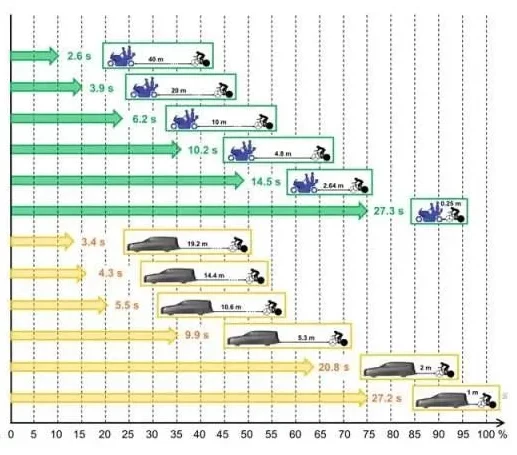
A similar effect can be seen with the cyclist drafting behind the car. This is enormous, and the conclusion here is clear: always stay behind any leading vehicle or rider, even if they are further away and you may not feel the draft. The animation below also illustrates how the draft effect becomes more “patchy,” but still, the air velocity is reduced, as illustrated by the green colors.
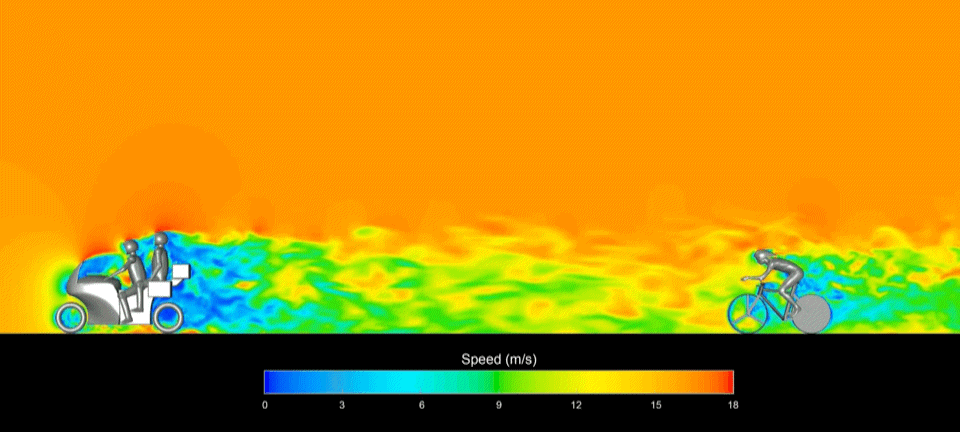
For reference, in most of Europe, the distance between two reflective poles at the side of most roads is about 50 meters. So as long as you are following a vehicle or other rider within that range, stay in the line behind them and profit from every little bit of advantage possible. Just make it a habit!
Make it a habit to always stay behind something! Even when 40 meters (!) behind a motorcycle, car, or another rider, you can still benefit from the draft.
Wheel suckers are bliss, they make you faster
One of the most surprising findings from Bert Blocken’s studies is that a cyclist’s speed can be positively affected by a vehicle following closely behind. Yes, you read that correctly. A motorcycle or car following a rider makes the cyclist go faster, as depicted in the image below, adopted from The Escape Collective.
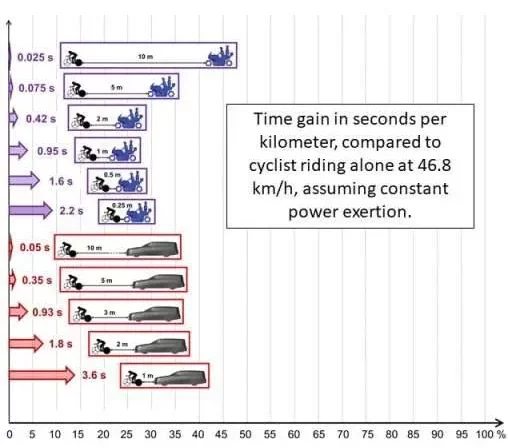
The illustration on the left shows how a following motorcycle or car affects a cyclist at different distances. The closer and bigger the following vehicle, the greater the effect. This also applies to “wheel suckers” in cycling. If someone drafts you, you will actually go faster. So, unless it’s a direct competitor trying to save energy, it’s best to let them be. Hopefully, this information will help lessen some discussions in Grand Fondos…
How is this possible? As we learned in the article on aerodynamics in cycling, the air pressure difference created by the high pressure in front of you and the low pressure behind you causes aerodynamic drag, which is the force that pulls you back. If a vehicle or another rider sits behind you, they increase the air pressure behind you, reducing the pressure difference between front and back. As a result, you experience less aerodynamic drag and can go faster. This is because the following vehicle also creates a high-pressure area in front of it, which intrudes the low pressure behind you.
A vehicle or other rider behind you will actually make you faster. They reduce the aerodynamic drag. Hard to believe, but wheel suckers are actually bliss! #CyclingMyth
It is a little bit complicated to explain with words, but maybe the illustration below can help. The following car pushes a high-pressure field in front of them. As a result, the rider has similar pressure in front and back (both in the same red color). This means aerodynamic drag is reduced because there is less of a pressure differential.
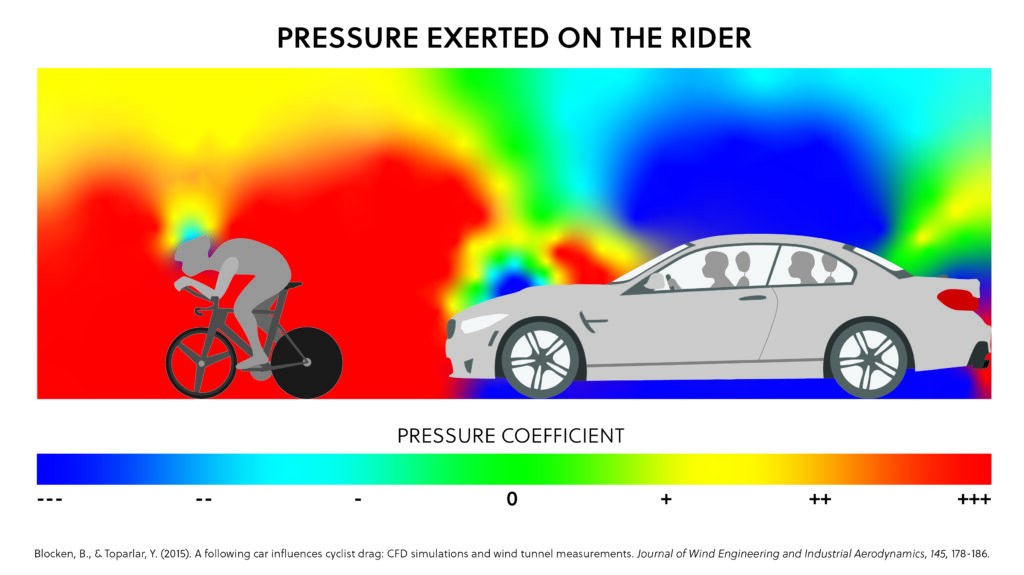
Bert Blocken’s research has prompted the UCI to alter the regulations for cars trailing time trial riders in World Tour races in 2023. Previously, team cars were permitted to follow at a minimum distance of 15 meters. However, the new research findings revealed a significant impact and the distance was increased to 25 meters.
To be most aero, you may not slam the stem
It is always beneficial to maintain an aerodynamic position while cycling, regardless of whether you are drafting or not. The images below can guide you on the amount of benefit each position can offer. However, it is crucial to prioritize your safety and control at all times. For example, top tube positions are not allowed in official road races as riders are required to have “the seat on the saddle.”
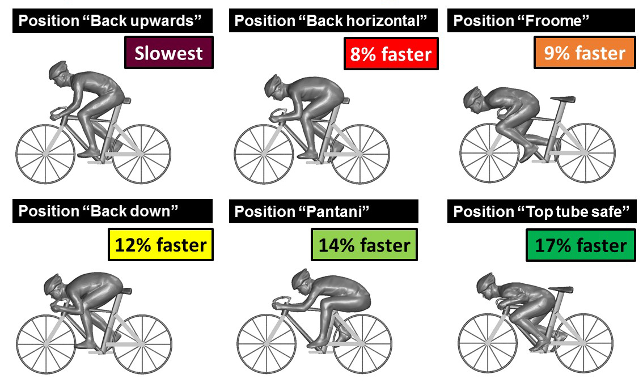
There is a common belief that lowering the handlebars or “slamming that stem” can make you faster. However, this may not be entirely true. Instead, it seems that minimizing the frontal area by having the back either horizontal or downward is more critical for speed. Achieving this with a very low handlebar requires the rider to have flexibility and core strength. If you lack these attributes, the position can be unsustainable and not very beneficial, possibly even causing back pain.
“Slamming that stem” for speed? It’s not always effective. Minimizing frontal area is key, requiring rider flexibility and core strength. Higher handlebars might help to get into better positions. #CyclingMyths
On the other hand, some riders may actually become more aerodynamic by increasing the stack height. This is because when the handlebar is higher, the rider can get their head closer to it, their back can be flatter, and their elbows can be more horizontal. This reduces the frontal area exposed to the wind, resulting in a more sustainable and aerodynamic position.
However, it’s important to note that in aerodynamics, everything needs to be thoroughly tested for the individual rider to make a definitive conclusion. This has been discussed extensively in part 2 of this series.
 Made me Slower
Made me Slower
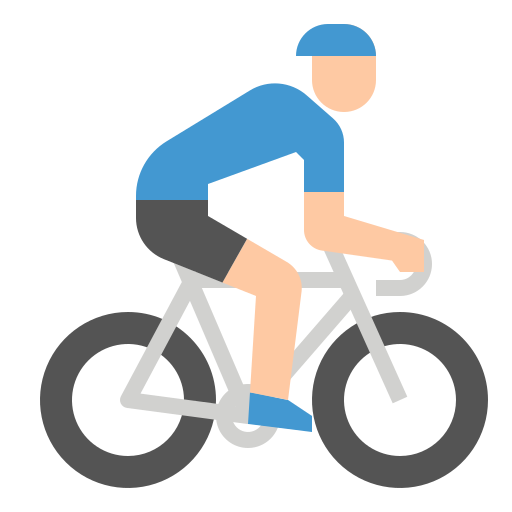 Same, Same
Same, Same
 Made me Faster
Made me Faster

